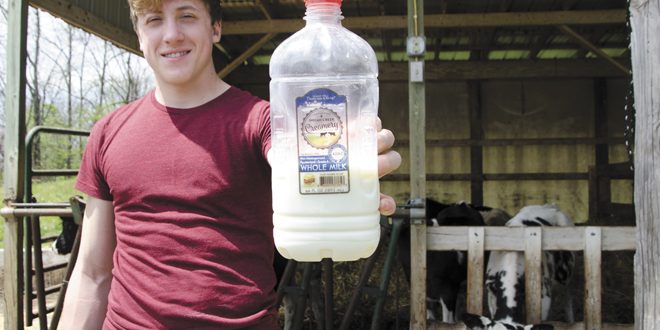|
By Matt Reese
Luke Jackson just finished up his sophomore year of high school at home and did not get to spend much of his spring on the baseball diamond with his teammates like usual. Not much has been usual, after all, in the spring of 2020. Luke loves sports of all kinds and has missed the athletic activity, but the coronavirus that kept him off the athletic fields also helped double the demand for his family’s Indian Creek Creamery in Logan County. As their new business boomed in recent weeks, Ray and Colleen Jackson were glad to have some extra help on the more than 70-head dairy farm from their two sons (Luke and Samuel, a student at Calvin University in Grand Rapids) who were both home from school due to the pandemic. Ray has been involved in the dairy industry most of his life and milking on the Logan County farm since 1991 and, in recent years, saw a need to respond to the increasingly challenging market conditions for milk. The Jacksons had a family meeting with their children a few years ago. They either had to do something differently, or get out of the dairy industry. The family decided they wanted to set the stage for a possible future for the four children — two boys and two girls — to continue in the dairy industry on the farm. “We were in a position to either get out of dairy or try something different and risk failing,” Ray said. “I have spent most of my career trying not to fail, and I have come close a couple of times.” Read the full article here: https://ocj.com/2020/06/creamery-business-booms-during-covid-19/
0 Comments
Ohio couple moves forward with dairy farming by giving a nod to the past.
Gail C. Keck | Apr 22, 2019 Dairy farmers Ray and Colleen Jackson have known for several years that they would need to make some big changes to continue milking cows on their family farm near De Graff, Ohio. With a milking herd of about 74, they aren’t producing enough volume to ship out the truckloads that many processors now prefer; and the prices they were getting weren’t offering much, if any, profit. “Doing what we’d been doing was not sustainable,” says Colleen. Their production system was already as efficient as they could make it, Ray adds. “We spent our whole lives learning how to make milk efficiently, now we have to learn new tricks.” About three years ago, the couple even called a family meeting with their teenage and young adult children to discuss whether they should give up on milking cows. “I just laid it all out after church one day,” Ray recalls. The consensus was to find some way to keep the cows; but to do that, they realized they needed more control of their milk market. They are hoping to get that control by bottling and selling their milk to customers eager for minimally processed dairy products. In February, they bottled their first jugs of unhomogenized, flash-pasteurized whole milk. “If this works, it will fix things financially,” says Ray. Read the full article here: https://www.farmprogress.com/dairy/dairy-determination Ray Jackson and his family are dairy farmers in western Logan County looking to diversify their product with what may be a trend on the horizon for the industry — something called a2 milk.
“It’s daunting right now, but we’re excited for the possibilities down the road,” said Jackson, who is a sales rep for ABS Global, formerly American Breeders Service along with working on the small dairy farm. Regular cow’s milk is about 85% water. The rest consists of lactose, fat, proteins, and more. About 30% of the total protein in that assembly is made up of beta-casein. Two variants of this protein are found in cow’s milk, a1 and a2. Cows are genetically predisposed to produce milk with either a1 or a2 proteins, though a new trend has recently raised the eyebrows of dairy farmers looking to cows that can produce a2 without any a1 beta-casein. Like in nearly every sector of the food industry, consumer preference has permeated through the store shelves to influence production at the dairy farm level. Proponents of a2 milk stand by the claim that it not only helps with digestion of dairy products, but that it is actually suitable for lactose intolerant individuals to consume without issue. The claim is gaining steam and warrants taking a deeper look into the research behind it as well as the dairy farmers looking to capitalize on the possibly emerging market. “The a1 and a2 proteins are naturally genetically occurring in cows,” Jackson said. “And of course like all traits there’s two genes for it so they can be homozygous a1, they can be heterozygous and have both genes, or they can be homozygous a2. The milk they produce is proportionate so they can actually make a blend of the two proteins or just one or the other.” Read the full article here: https://ocj.com/2016/10/the-intrigue-of-a2-milk/?fbclid=IwAR23aIi9BEkuA7YzkZONlOlCUYf-bkVEqR5W8_FokEvsBC4QY8n04ezGb9A |
ArchivesCategories |



